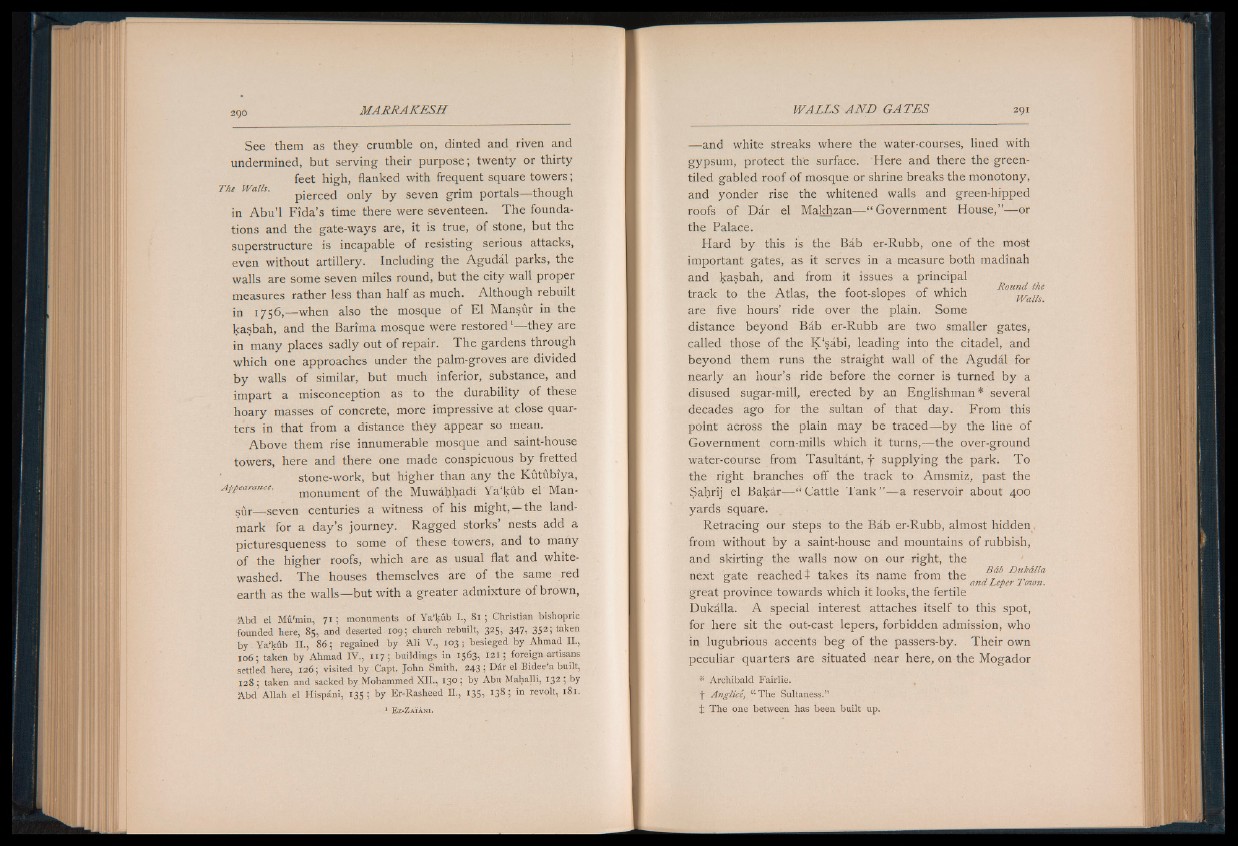
See them as they crumble on, dinted and riven and
undermined, but serving their purpose; twenty or thirty
feet high, flanked with frequent square towers; The Walls. pierceci oniy by seven grim portals— though
in Abu’l Fida’s time there were seventeen. The foundations
and the gate-ways are, it is true, of stone, but the
superstructure is incapable of resisting serious attacks,
even without artillery. Including the Agudal parks, the
walls are some seven miles round, but the city wall proper
measures rather less than half as much. Although rebuilt
in 1756,— when also the mosque of El Mansur in the
kasbah, and the Barima mosque were restored '— they are
in many places sadly out of repair. The gardens through
which one approaches under the palm-groves are divided
by walls of similar, but much inferior, substance, and
impart a misconception as to the durability of these
hoary masses of concrete, more impressive at close quarters
in that from a distance they appear so mean.
Above them rise innumerable mosque and saint-house
towers, here and there one made conspicuous by fretted
stone-work, but higher than any the Kutubiya,
Appearance. monument of the Muwahhadi Y a ’kub el Mansur—
seven centuries a witness of his might, —the landmark
for a day’s journey. Ragged storks’ nests add a
picturesqueness to some of these towers, and to many
of the higher roofs, which are as usual flat and whitewashed.
The houses themselves are of the same red
earth as the walls— but with a greater admixture of brown,
Abd el Mu'min, 71 ; monuments of Ya’kub I., 81 ; Christian bishopric
founded here, 85, and deserted 109; church rebuilt, 325, 347, 352; taken
by Ya’kub II., 86; regained by Ali V., 103; besieged by Ahmad II.,
106; taken by Ahmad IV., 117; buildings in 1563, 121; foreign artisans
settled here, 126; visited by Capt. John Smith, 243 ; D4r el Bidee’a built,
128 ; taken and sacked by Mohammed XII., 130; by Abu Mahalli, 132 ; by
Abd Allah el Hispani, 135; by Er-Rasheed II., 135, 138; in revolt, 181.
1 E z - Z a i a n i .
— and white streaks where the water-courses, lined with
gypsum, protect the surface. Here and there the green-
tiled gabled roof of mosque or shrine breaks the monotony,
and yonder rise the whitened walls and green-hipped
roofs of Dar el Makhzan— “ Government House,”— or
the Palace.
Hard by this is the Bab er-Rubb, one of the most
important gates, as it serves in a measure both madinah
and kasbah, and from it issues a principal
track to the Atlas, the foot-slopes of which
are five hours’ ride over the plain. Some
distance beyond Bab er-Rubb are two smaller gates,
called those of the K ’sabi, leading into the citadel, and
beyond them runs the straight wall of the Agudal for
nearly an hour’s ride before the corner is turned by a
disused sugar-mill, erected by an Englishman* several
decades ago for the sultan of that day. From this
point across the plain may be traced— by the line of
Government corn-mills which it turns,— the over-ground
water-course from Tasultant, f supplying the park. To
the right branches off the track to Amsmiz, past the
Sahrij el Bakar— “ Cattle T an k ”— a reservoir about 400
yards square.
Retracing our steps to the Bab er-Rubb, almost hidden.
from without by a saint-house and mountains of rubbish,
and skirting the walls now on our right, the
next gate reached t takes its name from the Du^ lla ° ^ s ana Leper 1 own.
great province towards which it looks, the fertile
Dukalla. A special interest attaches itself to this spot,
for here sit the out-cast lepers, forbidden admission, who
in lugubrious accents beg of the passers-by. Their own
peculiar quarters are situated near here, on the Mogador
* Archibald Fairlie.
f Anglice, “ The Sultaness.”
t The one between has been built up.